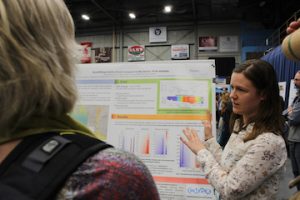2019 MSWC Winning Student Poster Highlight: Quantifying Tidally Driven Transport in the Jordan River Estuary
Quantifying Tidally Driven Transport in the Jordan River Estuary
Undergraduate
Gwyneth Roberts, University of Maine
Honorable Mention

Pollution events in tidal estuaries can wreak havoc on aquaculture operations, leading to closures of areas for weeks at a time and a significant loss of revenue. These pollution events are inherently linked to the dynamics of the estuary.
Gwyneth Roberts, an undergraduate student pursuing dual degrees in Ecology & Environmental Sciences and Mathematics at UMaine, has been conducting research focused on understanding tidal processes in the Jordan River estuary in Trenton, Maine under the supervision of Lauren Ross in Civil and Environmental Engineering, Sean Smith in Earth and Climate Sciences and Thomas Bellsky in Mathematics.
The work is in direct coordination with the de Koning family, owner of Acadia Aqua Farms (AAF) in Trenton, and an important stakeholder involved with shellfish harvesting in Maine.
Subtidal flow—circulation in an estuary on timescales longer than that of the tide—drives pollutant transport, which is of interest to local aquaculture operations such as AAF’s blue mussel beds housed at the mouth of the Jordan River estuary. Such local aquaculture operations are susceptible to both point source pollution (discharge from a pipe, for example) and freshwater-runoff from diffuse sources (non-point source pollution).
Roberts’ study aims to characterize the circulation patterns in the Jordan River estuary on various time scales to identify the controls of material transport in this system. In order to achieve this goal, a combination of in-situ (samples taken from the estuary waters) collected data and analytical modeling was used to understand water level variations and tidal current velocity patterns in the river. It also improves the understanding of the hydrodynamic conditions (describing the motion of fluids) and their implications for water quality.
An analytical model was used to identify the overall structure and the physical processes responsible for subtidal circulation. Modeling suggests that pollutants introduced to the system near the banks (from land-based sources) will be transferred out of the system while pollutants introduced in the center (or from the seaward boundary) will be transferred into the system. Thus, land-based pollutants will spend less time within the estuary. These results can be used to inform management decisions to minimize closure time throughout the harvest season.
Throughout the planning and execution of the fieldwork necessary for this project, AAF has provided enthusiastic support. Thanks in no small part to their continued cooperation, the project will expand during this coming year to account for seasonal variations in river discharge and tidal phase.
